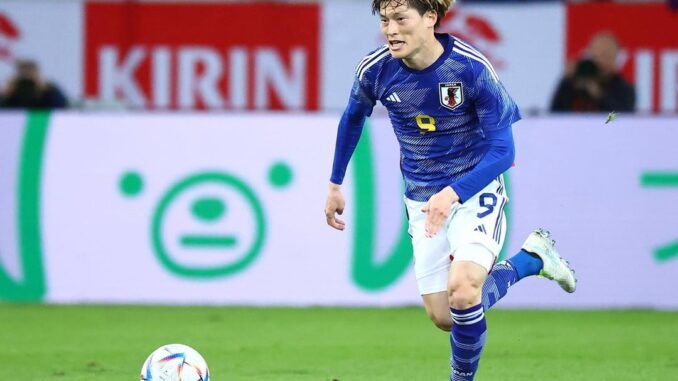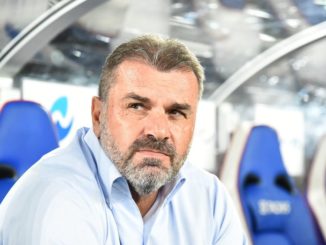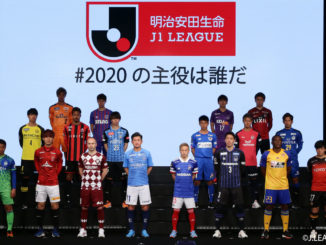

The Asian Game’s coverage of the FIFA World Cup Qatar 2022 is proudly sponsored by SMC.
At the end of pretty much every friendly match that Japan plays there’s a collection of giant cardboard cut outs, usually involving an oversized alcoholic beverage, that the visiting captain is forced to uncomfortably pose in front of.
Things were slightly toned down this week when a monotone Hajime Moriyasu named, player by player as if he were reading the class roll, his 26-man squad that will carry the nation’s hopes in Qatar.
Still, less than 20 centimetres away from the Japan coach, were a couple of actual beers – the kind that Celtic supporters may be reaching for with the news that Kyogo Furuhashi and, to a lesser degree, Reo Hatate didn’t make that final cut.
In a squad of few surprises the omission of Furuhashi, along with Yuya Osako and Genki Haraguchi, count as the most notable whilst Nagoya’s Yuki Soma is the closest that the conservative Japan boss will ever have to being a bolter.
Otherwise it was pretty much as expected; the same collection of goalkeepers, fullbacks, central defenders, wide and central midfielders that have started most of Japan’s recent full internationals.
Up front things are more interesting though as there was, oddly, only one pure striker named in the group and that’s Belgium-based Ayase Ueda, a player that’s never scored a senior international goal.
Daizen Maeda, Takuma Asano and Daichi Kamada can and have played up front previously but none are out and out number nines and that speaks loudly as to how Moriyasu intends to play in a tough group that contains Germany and Spain.
Right back to his days at Sanfrecce Hiroshima, Moriyasu has valued a defensive solidity that borders on rigidity where individual creativity is sacrificed for team cohesion and control and this squad is one very much constructed with the same ethos as its central tenet.
The signs have long been there that Furuhashi was far from a certaintity to make the final cut; of the last 13 matches where the regular national team players were available and he was fit, the Celtic man started just three times and was regularly pitched in late off the bench.
His movement between and along the lines in Celtic’s 4-3-3 always seemed to suit him more than as a winger or lone striker in what seems certain to be a 4-2-3-1 that Japan will play in Qatar.
In that sense, a fit-again Osako is perhaps the biggest surprise given that his ability to drop deeper or play as a more traditional nine in the box to meet crosses from wide is a far greater fit with what Moriyasu demands of his lone striker.
In a press conference where, as usual, Moriyasu gave few detailed answers about individual players, there were hints towards performance related data and fitness concerns that may have counted against Osako – who has missed a large chunk of the domestic season for Vissel Kobe – and that means it’s increasingly likely we’ll see 24-year-old Ueda, with five goals in 15 league matches for Cercle Brugge, lead the line for Japan.
In fact most of the XI seemingly picks itself: Shuichi Gonda in goal, Takehiro Tomiyasu and Maya Yoshida in central defence, Wataru Endo and Hidemasa Morita (or perhaps Ao Tanaka if he’s fit) in central midfield, the curious Junya Ito on the right, either Takefusa Kubo or Kaoru Mitoma on the left and Kamada as the 8/10 hybrid.
Perhaps the only role where there’s real competition is in the fullback spots where Hiroki Sakai and Miki Yamane are options on the right and Yuto Nagatomo and Yuta Nakayama will battle it out for a start on the left.
With the exception of the wingers it’s a functional, hard-working XI, with little flair or creativity and my belief all along is this is exactly how it would be under Moriyasu.
Equally, it’s not my belief at all that this style best suits the characteristics of the deep and talented pool of players he could have called upon and that Japan shouldn’t be heading into a World Cup looking to contain and limit their group opponents, but rather aim to dominate matches themselves.
The course that has long been charted by Moriyasu though has led us to this point where form, function and discipline are placed ahead of creativity, expression and attacking imposition.
It’s a shame and I don’t think it represents the best qualities of Japanese football but it’s what we have and his squad selections speak clearly to how we’ll see them play in Qatar; buckle up for what could be an underwhelming ride.
PHOTO: Instagram/japanfootballassociation
Listen to the latest episode of The Asian Game Podcast as Scott travels to Okayama to talk with Stefan Mauk




